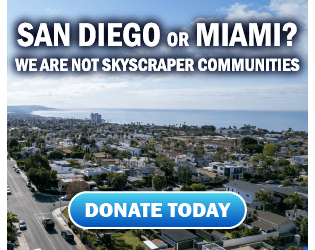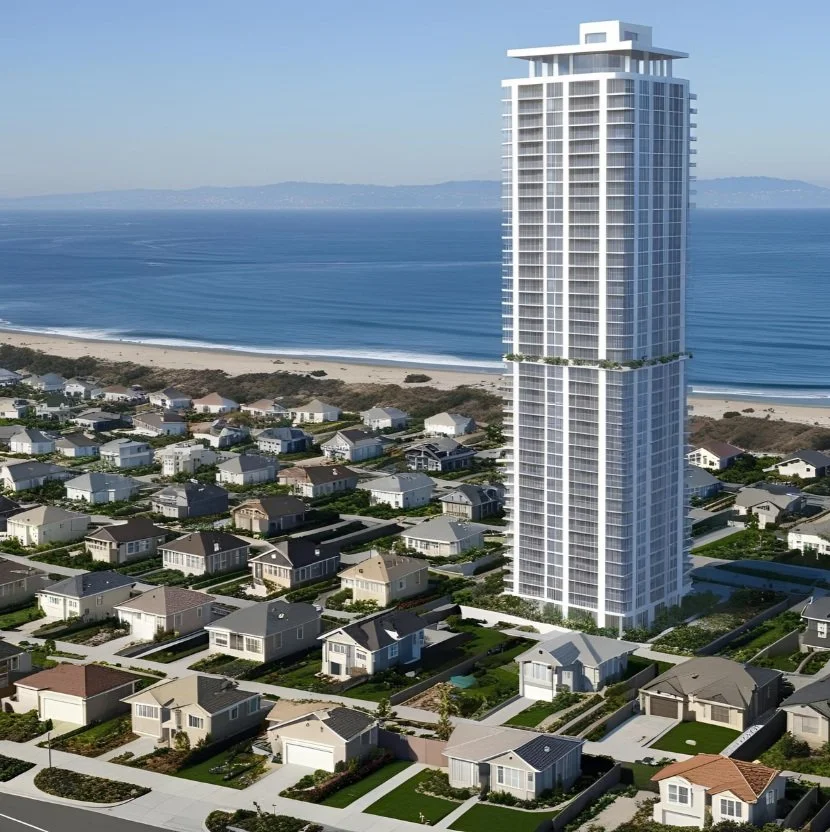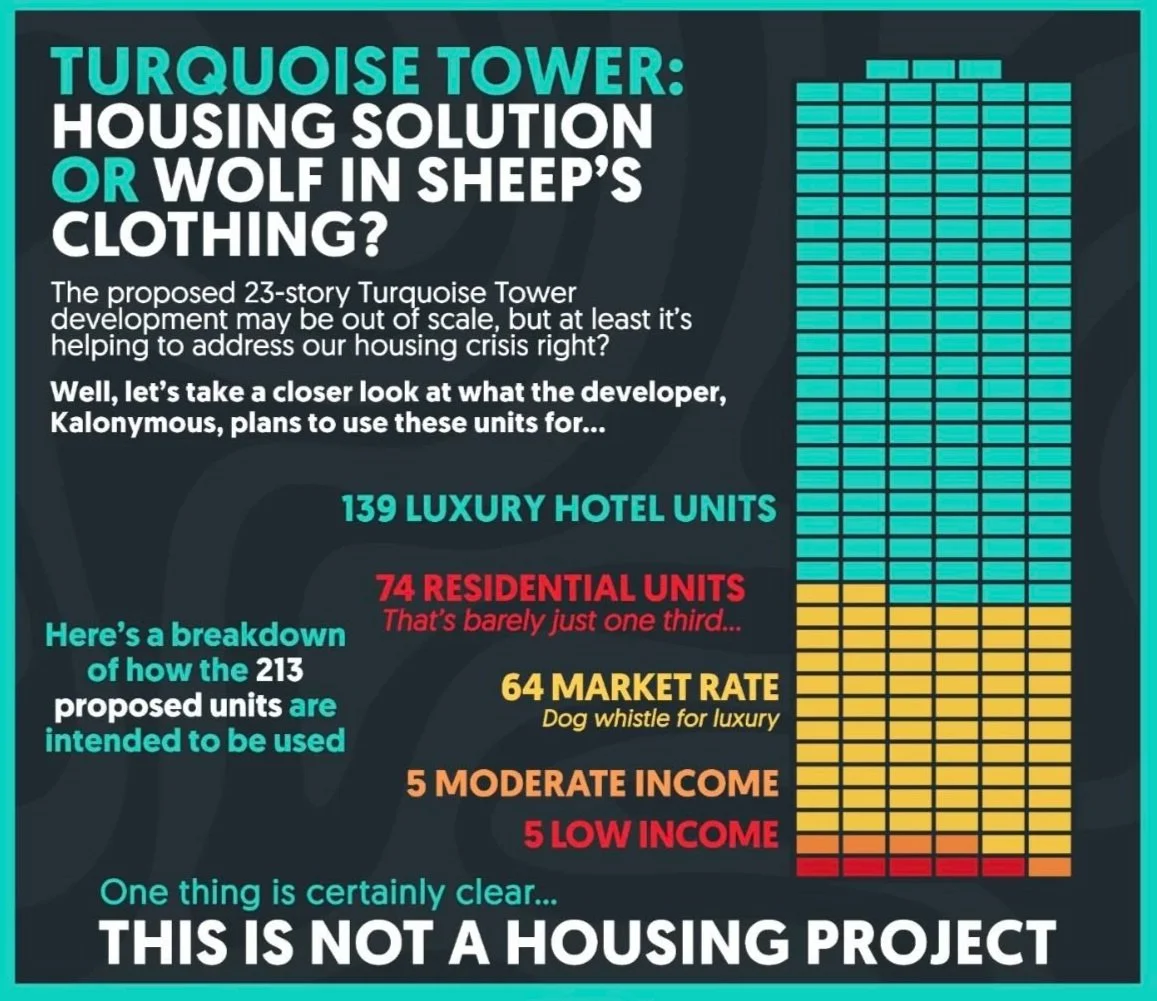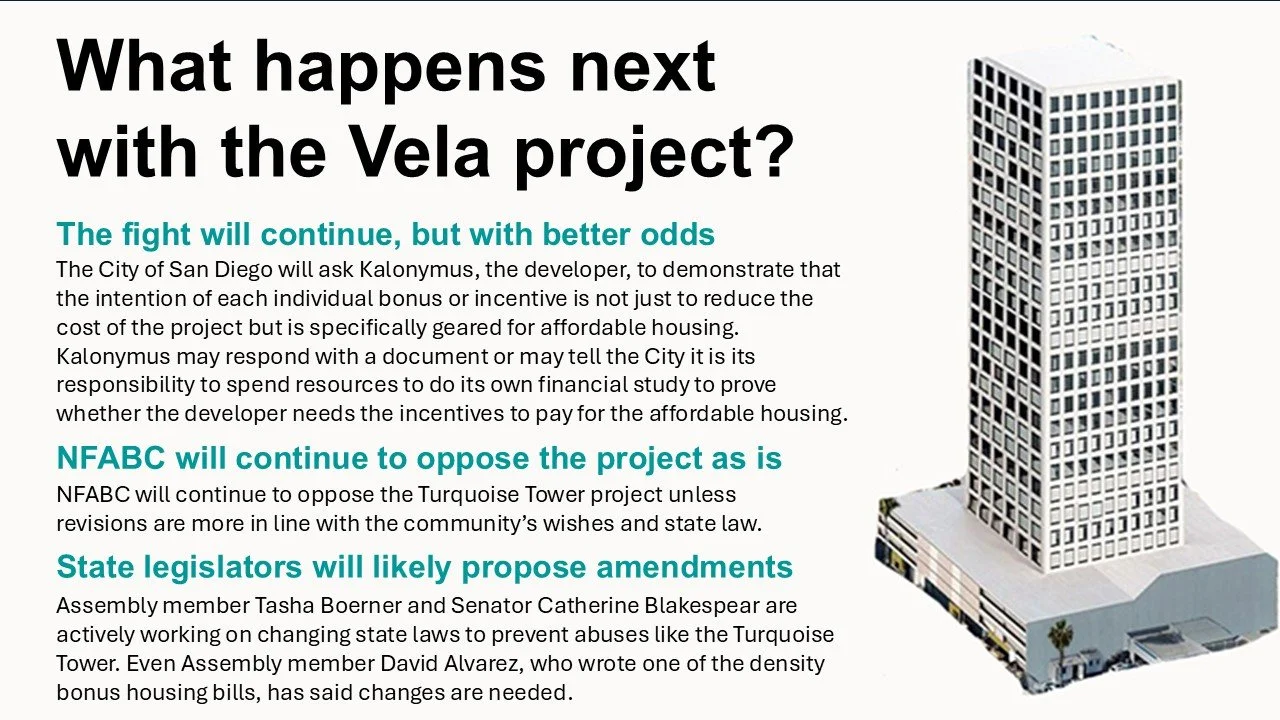The Turquoise Tower Threatens Pacific Beach and Sets a Dangerous Coastal Precedent for All of California.
On October 21, 2025, the high powered law firm Allen Matkins, representing Kalonymus Development Partners, LLC, sent a three page letter to the City’s Development Services Department. In that letter, they claim their 23 story “Project Vela” also known as “Turquoise Tower” at 954 to 980 Turquoise Street is already approved “by operation of law” and demand that the City immediately issue building permits.
Make a donation
Support our legal fund by contributing today.
Project Vela: Why This 23-Story Tower Threatens Every San Diego Neighborhood
Project Vela is a proposed 23-story tower on a tight 0.8-acre site in North Pacific Beach—far beyond what the community plan ever envisioned. But the real concern isn’t just the size of the building. It’s how the developer is trying to get it approved.
Recent documents—only released after NFABC hired an outside attorney—show that the developer’s law firm is claiming the project is already “deemed approved” and that the City must immediately issue building permits with no further review.
Their argument relies on a combination of:
SB 330 “vesting” to freeze the most favorable rules in place
AB 130 “deemed approved” claims based on tight timelines
A demand that City staff treat a 23-story luxury tower as a simple ministerial permit—the same category as a kitchen remodel
If this strategy succeeds, it won’t stop with Pacific Beach. This will become the new playbook statewide: use legal deadlines and technical arguments to bypass public hearings, community plans, and environmental review.
Why This Matters for San Diego
1. A dangerous precedent for every community
If a 23-story tower can be labeled “by-right” here, virtually any neighborhood—La Jolla, Clairemont, Ocean Beach, City Heights—could be next.
2. The “deemed approved” tactic shuts out the public
Developers are increasingly using threat letters and missed-deadline claims to bypass hearings and CEQA entirely.
3. Transparency failures make oversight impossible
Key documents were not provided through the City’s public records portal and were only released after NFABC involved legal counsel.
4. It replaces real planning with quiet checkbox approvals
A project of this scale deserves rigorous review. Calling it “ministerial” erases neighborhood input and undermines decades of community planning.
What NFABC Is Doing Right Now
Pressing City leadership
We are meeting with the Mayor’s Office and Council District 1 to demand a clear position:
Is Project Vela already “deemed approved,” or will the City defend real oversight?
Challenging the ministerial classification
We are requesting written justification for treating a high-rise tower as a simple plan-check item.
Demanding transparency
We are seeking internal legal memos, the full density bonus file, and records that were withheld or delayed.
Preparing legal action
If the City attempts to issue permits under this theory, NFABC is ready to support:
Formal legal challenges
Public records enforcement
A potential Temporary Restraining Order (TRO) to pause construction
Keeping residents informed
We continue to publish documents, updates, and action alerts so the community is never blindsided.
Make a donation.
Help Us Stop the Tower — Defend Our Neighborhoods
Your donation powers our legal fight to protect our community from reckless high-rise development. Every dollar supports legal action, expert analysis, and advocacy to preserve the character, safety, and livability of our neighborhoods.
500+ Neighbors Stand Together Against SB 79 & Turquoise Tower.
Our community showed up loud and proud — and this rally proved we are not alone.
Over 500 neighbors gathered in Pacific Beach to say NO to out-of-scale towers, and YES to protecting our neighborhoods.
This powerful 2.5-minute recap shows what happens when everyday people rise up and demand better from our elected officials.
📣 The message is clear: We will not be ignored.
Why it matters
Not Anti-Housing — Just Pro-Community
Neighbors for a Better California (NFABC) supports responsible, community-centered housing development. The proposed 23-story high-rise at 970 Turquoise Street would tower 238 feet into the sky—violating local height limits and threatening the character of Pacific Beach. This project isn't about solving the housing crisis—it’s about developer profit at the community’s expense.
This isn’t about opposing housing. It’s about a system that has been quietly rigged:
• Hotel rooms are masquerading as housing
• Transit definitions are being stretched beyond recognition
• The City is forced to prove why a skyscraper isn’t necessary—instead of the developer proving why it is
Meanwhile, taxpayer money is being spent to defend community plans—plans that the public helped create.
The Turquoise Tower: How Can This Even Be Allowed?
Understanding the Legal Loopholes Fueling an Out-of-Scale Project in a Coastal Neighborhood
The proposed Turquoise Tower is a luxury high-rise planned in a modest coastal neighborhood. It’s tall, dense, and completely out of step with local zoning, infrastructure, and design guidelines.
So how is it possible?
Because it exploits state housing laws, local bonus programs, and legal loopholes that shift all the power to developers. Let’s walk through how this works—and why it matters.
1. State Laws Override Local Zoning—and the City Can’t Push Back
Developers of the Turquoise Tower, Kalonymus LLC (developer) are using laws like:
• The State Density Bonus Law (Gov. Code §65915)
If they add a few affordable units, they can demand extra height, more units, reduced parking, and bypass most design rules.
• The Housing Accountability Act (Gov. Code §65589.5)
If a city denies the project -even for valid reasons - they can be sued, and courts almost always side with the developer with high priced legal teams.
2. Fake Transit = Real Towers
Turquoise Tower developer claim the project qualifies for “Transit Priority Area” bonuses—because of a nearby bus stop.
But:
• That stop doesn’t offer high-frequency, all-day service
• There’s no trolley or rail nearby
• The area is still car-dependent
This “Fake Transit” designation opens the door to density bonuses never meant for this kind of neighborhood.
3. It’s Zoned Mixed-Use—But the Project Is Neither True Housing nor a True Hotel
The Turquoise Tower is proposed on mixed-use zoned parcels, which allows a combination of commercial and residential uses. But the developer isn’t building a clear version of either.
Instead, they’re proposing:
• 30+ day furnished “rental suites”—not apartments with long-term leases
• No front desk, no concierge, no public reception, no hotel-style services
• No lobby or amenity space typical of a hotel
• Units designed more like corporate suites or furnished rentals than homes
This means the project is:
Not a true hotel (so it avoids hotel taxes, CEQA commercial analysis, and city hotel planning rules)
Not true housing (so it avoids long-term residential oversight, lease protections, and parking expectations)
Yet by claiming it’s housing, the developer is attempting to unlock:
• Extra density and height under the State Density Bonus Law
• Ministerial approval with no public hearings
• Reduced parking and infrastructure requirements
• A legal shield from discretionary city oversight
This is purpose-built ambiguity. The developer is threading the needle between two categories to maximize profit while minimizing accountability.
4. City of San Diego Adds More Bonuses for 3-Bedroom Units
City law gives extra density for including 3-bedroom units—even if:
• They’re not affordable
• They’re not intended for families
• They’re just larger “suites” marketed to high-income tenants or travelers
This is the “3-Bedroom Bonus”, and it’s being stacked on top of the state incentives under the pretense of family housing, and yet it has no affordability requirement.
5. Developer Inflates FAR with Hotel + Garage—Even Though It’s Not Allowed
The developer claims a Floor Area Ratio (FAR) of 8.37 by counting the entire 408,641 sq ft building - including hotel rooms and the 7-story parking structure.
But under California law:
Only the 74 housing units are allowed to count toward FAR and density bonus calculations—not the 139 commercial hotel-style units or the garage.
They’re inflating the numbers because they can—and the City may let them.
To quote a certain malignant narcissist:
“If you’re going to lie, lie big.”
This FAR is a big lie.
6. Burden of Proof Is Backwards. And Taxpayers Pay the Price
This is where it gets even more unfair.
• The developer proposes 10 affordable units (5 very low income, 5 moderate)
• Demands massive height and density bonuses
• State law requires the City - not the developer - to prove those bonuses aren’t needed
To do that, the City has to:
• Hire outside consultants
• Build financial models
• Spend your tax dollars just to try to say “no”
If the City can’t prove a negative, the project must be approved - by default.
7. All Approved Through a Ministerial Permit
This entire project is being processed as “ministerial permit”—meaning:
• No public hearings
• No CEQA environmental review
• No oversight by the Planning Commission or City Council
• No chance for community feedback
A tower that will impact traffic, schools, infrastructure, parking, fire services, and views is being approved like a kitchen remodel.
8. Taxpayers Pay for Infrastructure Upgrades
The Turquoise Tower adds major density to an aging neighborhood but the developer isn’t required to fund the necessary upgrades.
Instead, you will.
• New traffic signals? Taxpayer-funded.
• Water and sewer upgrades? Taxpayer-funded.
• Increased demand on emergency services? Taxpayer-funded.
• School overcrowding? Taxpayer-funded.
This is public subsidy for private profit.
9. City Transparency Has Been Minimal—and Fear May Be Driving It
San Diego’s Development Services Department (DSD) has been unwilling or unable to answer basic questions about how they’re evaluating this project:
• Is the developer correctly applying the Density Bonus Law?
• How are they justifying hotel use under housing laws?
• Is the 3-bedroom bonus being applied properly?
• What modeling is being done to assess financial need for the bonuses?
Despite community inquiries, DSD has provided almost no clear answers.
Why?
Like many cities, San Diego may be afraid of being sued by the developer’s high-powered legal team, known to work with Turquoise Tower’s real estate investor developer Kalonymus LLC, who is behind similar controversial projects statewide.
This is the chilling effect of California’s housing law:
Cities are scared into silence, and the public is locked out.
Turquoise Tower: City Still Pushing for Answers
Status Update — Closely Monitored by NFABC (November 2025)
The proposed 23-story Turquoise Tower project in Pacific Beach remains under city review. On September 24, the City Planning Department issued its second round of questions to the developer, pressing for clarification on several disputed claims and bonuses.
➡️ This is only the second of what is usually six or more review cycles — meaning the project is far from final approval.
City planners are questioning whether the developer’s requests for extra height and density under AB 1287, SB 436, and local city incentives actually qualify. NFABC continues to monitor these reviews closely.
Key Issues Under Review
Three-Bedroom Bonus:
The developer seeks a 10% unit increase for including “family-sized” homes. The City has asked for proof that those units meet the legal definition.Structured Parking Bonus:
The developer wants a 1.0 FAR bonus for a garage design that currently does not qualify under city rules.Parking in Front of the Property:
City regulations prohibit parking in the front setback. The developer denies doing so, but earlier plans showed parking there — prompting the City to demand clarification.
Why It Matters
City staff believe the developer’s claimed Floor Area Ratio (FAR) of 8.47 is not supported. Based on their analysis, the actual allowable FAR is closer to 4.5, with some plan data suggesting totals as high as 12.9–14.8 — far exceeding local zoning.
The developer also claims the building qualifies for automatic approval because it is “two-thirds residential.” However, City calculations show it’s 52% residential and 48% hotel, falling short of that threshold. To reach it, the developer counts the entire parking garage as residential space — a point city staff strongly dispute.
Finally, parking data raises new questions. The project needs 139 residential spaces, but includes 292, suggesting a hotel-focused design rather than true housing.
Transparency and Public Access
Although the Pacific Beach Planning Group requested access to the City’s review documents, those requests went unanswered. NFABC had to retain legal counsel to obtain the materials — highlighting how limited public access has become under California’s new ministerial housing laws.
Importantly, the City has not yet confirmed whether Turquoise Tower even qualifies for the ministerial approval process. NFABC will continue to press for full documentation, public transparency, and legal accountability before any approval moves forward.
What You Can Do
Sign up for Action Alerts
Educate others about how the system is being gamed.
Push state legislators to fix the burden-of-proof problem in Density Bonus Law.
Write to your City Councilmember
Ask the Following Questions:
Why is the City approving commercial hotels under housing law?
Why is DSD silent on basic public questions?
Why is ministerial approval being used for high-rise projects?
Join our Legislative Committee
Demand reform:
No density bonuses on commercial hotel projects
No ministerial rubber-stamping for high-rises
Shift the burden of proof back to developers
Require transparency from city departments.

If this tower moves forward, it will embolden similar developments across California’s coastal cities. NFABC believes that state laws should support—not steamroll—community needs. The future of our neighborhoods should be shaped by the people who live in them, not dictated by Sacramento.
What’s Wrong with the Turquoise Tower?
-
Exceeds the 30-foot Prop D coastal limit and local 60-foot zoning for this area.
-
Just 10 out of 74 residential units are affordable—while 139 hotel units dominate the building.
-
Due to state housing mandates, the City of San Diego has little authority to stop it—even if it breaks local rules.
-
Built on a narrow street operating 400% over traffic capacity and used as an evacuation route.
-
If allowed, this will open the door to more high-rises along San Diego’s beloved coastline.
Public Opposition to Turquoise Tower.

Ready to keep the fight going?
Support the cause
Take Action
Get Involved Before It’s Too Late
Sign up to stay informed
Speak out at local meetings
Donate to fund legal and advocacy efforts
Attend the next City hearing (calendar link)












